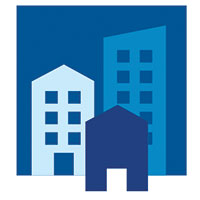Reform Local Codes
Many local zoning codes are still based on an almost 100-year-old framework that prioritizes best practices from a previous generation. Practices like separating uses and encouraging more space for automobiles than people are still far too common.
Needed: codes for today and tomorrow ...

Communities need to review and modernize codes and planners need resources to make updates happen. Outdated codes paralyze sound planning efforts, leading to income disparities, uncoordinated development, poor land use and, inevitably, housing problems. Communities should adopt or revise codes to enable mixed uses, offer a variety of housing types and price points, and increase the number of places to build while attending to equity and resiliency. States can play an important role in supporting this effort.
... and more options, higher quality
In practice, this may mean reducing or eliminating minimum lot-size requirements, allowing greater height and density, allowing accessory dwelling units, and reducing off-street parking requirements. Modernized codes incorporate the principles of transit-oriented development with emphases on locating housing near public transportation and existing infrastructure and expanding opportunities for non-traditional housing types. These include micro-apartments and accessory dwelling units.
A lower cost of construction does not always translate into a high-quality, affordable unit. The total cost of occupancy or ownership, not simply the cost of production or acquisition, should be taken into consideration when looking at local building and zoning codes. Building techniques that reduce maintenance and risk, while costlier at the outset, may have a substantial positive impact on the total cost of occupancy over time. For example, exceeding minimally acceptable insulation requirements during construction will typically reduce utility bills over the tenancy of the dwelling unit.
Dig In
These APA resources illuminate the issue and prepare you to act in your community.

Planning Home Case Study: San Francisco, California
Accessory Dwelling Unit (ADU) and Unit Legalization Program

PAS Report
Model Land Development Regulation Guide

Zoning Practice
Driving Housing Production

Zoning Practice
Less Parking, More Housing


